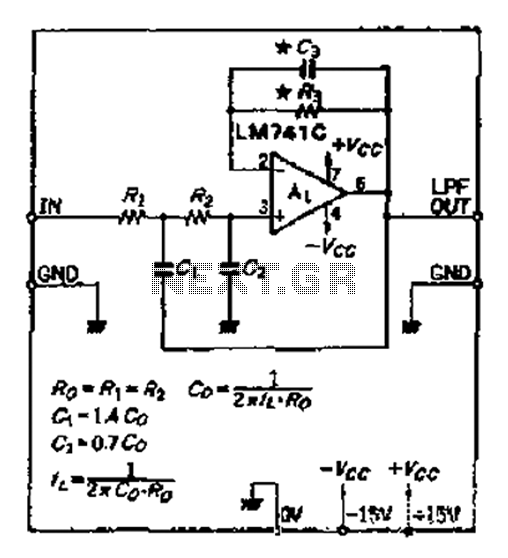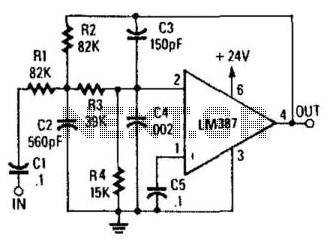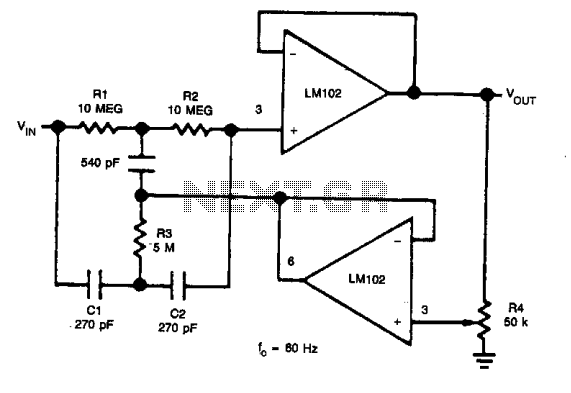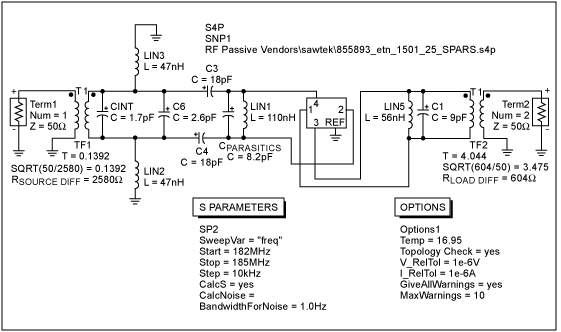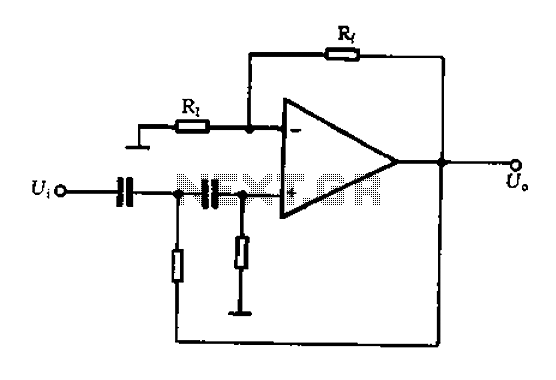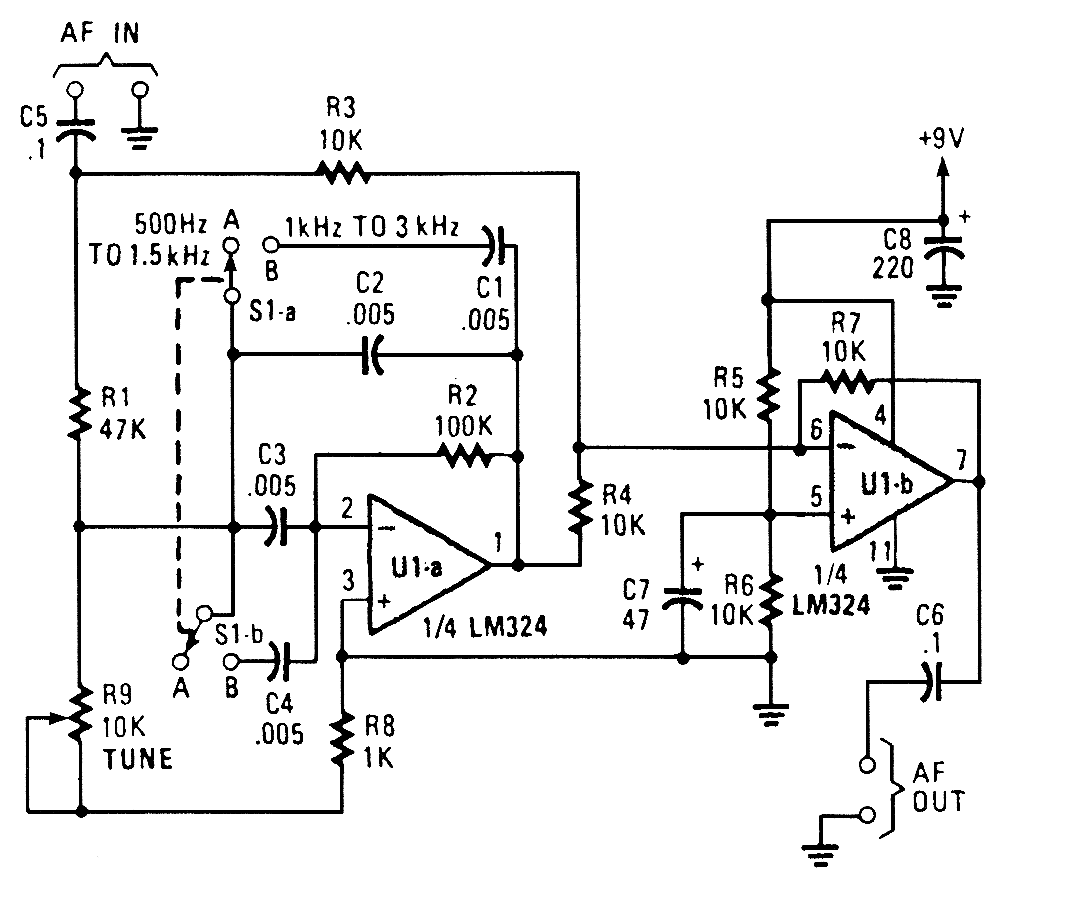
Tunable Bandpass Filter

One of the challenges in designing higher-order tunable bandpass filters is achieving proper tracking of the variable resistors in the RC networks. The implementation of switched capacitor networks can resolve this issue, as demonstrated in this filter. The filter can be roughly divided into two stages: an oscillator that manages the electronic switches and the four phase-shift networks that provide the actual filtering. The oscillator, based on a 555 timer, generates a pulsating signal with an adjustable frequency over a wide range, with a duty cycle varying from 1:10 to 100:1. Electronic switches ES1 through ES4 act as variable resistors, with their resistance dependent on the frequency of the digital signal. The operation of these switches is straightforward; when closed, their resistance is approximately 60 ohms, and when open, it is virtually infinite. If a switch is closed for about 25% of the time, its average resistance becomes approximately 240 ohms. By varying the open-to-closed ratio of each switch, the equivalent average resistance can be adjusted. The switching rate of these switches must exceed the highest audio frequency to prevent audible interference between the audio and clock signals. The input signal produces a specific direct voltage across capacitor C1, allowing the operational amplifier to function in a quasi-symmetric manner despite the single supply voltage. The direct voltage is eliminated from the output signal by capacitor C10. The fourth-order filter depicted in the diagram is applicable across the entire audio range and provides an amplification of around 40, although this is somewhat dependent on the clock frequency. The bandwidth is primarily determined by the set frequency, and the circuit consumes a current of no more than 15 mA.
The described circuit is a sophisticated implementation of a tunable bandpass filter utilizing switched capacitor technology to enhance performance and reliability. The 555 timer oscillator serves as the core timing element, generating a precise square wave signal that controls the switching of electronic components. This oscillator's output frequency can be fine-tuned, allowing for versatile application across various audio frequencies.
The electronic switches, identified as ES1 through ES4, play a critical role in modulating resistance within the filter circuit. By effectively acting as variable resistors, these switches enable dynamic adjustment of the filter's characteristics in real time. The design ensures that when a switch is activated, its low resistance allows signal flow, while its high resistance when deactivated prevents signal loss, maintaining the integrity of the filtering process.
The operational amplifier’s configuration is integral to the filter's functionality, allowing it to operate efficiently with a single supply voltage. The use of capacitor C1 stabilizes the input signal, ensuring that the op-amp maintains a balanced output. Capacitor C10 further refines the output by blocking any DC offset, ensuring that only the desired AC signal is present at the output.
The fourth-order filter design is particularly advantageous for audio applications, providing a significant gain while maintaining a manageable current draw of 15 mA. This low power consumption makes it suitable for battery-operated devices. The bandwidth of the filter, adjustable via the oscillator frequency, allows it to be tailored for specific audio applications, ensuring optimal performance in various scenarios. Overall, the described circuit exemplifies a practical solution for achieving high-fidelity audio filtering with tunable characteristics. One of the difficulties in the design of higher-order tunable bandpass filters is achieving correct tracking of the variable resistors in the RC networks. The use of switched capacitor networks can obviate that difficulty, as is shown in this filter. The filter can be divided roughly into two stages: an oscillator that controls the electronic switches arid the four phase-shift networks that provide the filtering proper. The oscillator, based on a 555, generates a pulsating signal whose frequency is adjustable over a wide range: the duty factor varies from 1:10 to 100:1.
Electronic switches ESI through ES4 form the variable resistors whose value is dependent on the frequency of the digital signal. The operation of these switches is fairly simple. When they are closed, their resistance is about 60 ; when they are open, it is virtually infinitely high.
a switch is closed for, say, 25% of the time, its average resistance is therefore 240 . "Varying the open:closed ratio of each switch varies the equivalent average resistance. The switching rate of the switches must be much greater than the highest audio frequency to prevent audible interference between the audio and the clock signals. The input signal causes a given direct voltage across CI, so the op amp can be operated in a quasisym-metric manner, in spite of the single supply voltage.
The direct voltage is removed from the output signal by capacitor C10. The fourth-order filter in the diagram can be used over the entire audio range and it has an amplification of about 40, although this depends to some extent on the clock frequency. The bandwidth depends mainly on the set frequency. The circuit draws a current of not more than 15 mA. 🔗 External reference
The described circuit is a sophisticated implementation of a tunable bandpass filter utilizing switched capacitor technology to enhance performance and reliability. The 555 timer oscillator serves as the core timing element, generating a precise square wave signal that controls the switching of electronic components. This oscillator's output frequency can be fine-tuned, allowing for versatile application across various audio frequencies.
The electronic switches, identified as ES1 through ES4, play a critical role in modulating resistance within the filter circuit. By effectively acting as variable resistors, these switches enable dynamic adjustment of the filter's characteristics in real time. The design ensures that when a switch is activated, its low resistance allows signal flow, while its high resistance when deactivated prevents signal loss, maintaining the integrity of the filtering process.
The operational amplifier’s configuration is integral to the filter's functionality, allowing it to operate efficiently with a single supply voltage. The use of capacitor C1 stabilizes the input signal, ensuring that the op-amp maintains a balanced output. Capacitor C10 further refines the output by blocking any DC offset, ensuring that only the desired AC signal is present at the output.
The fourth-order filter design is particularly advantageous for audio applications, providing a significant gain while maintaining a manageable current draw of 15 mA. This low power consumption makes it suitable for battery-operated devices. The bandwidth of the filter, adjustable via the oscillator frequency, allows it to be tailored for specific audio applications, ensuring optimal performance in various scenarios. Overall, the described circuit exemplifies a practical solution for achieving high-fidelity audio filtering with tunable characteristics. One of the difficulties in the design of higher-order tunable bandpass filters is achieving correct tracking of the variable resistors in the RC networks. The use of switched capacitor networks can obviate that difficulty, as is shown in this filter. The filter can be divided roughly into two stages: an oscillator that controls the electronic switches arid the four phase-shift networks that provide the filtering proper. The oscillator, based on a 555, generates a pulsating signal whose frequency is adjustable over a wide range: the duty factor varies from 1:10 to 100:1.
Electronic switches ESI through ES4 form the variable resistors whose value is dependent on the frequency of the digital signal. The operation of these switches is fairly simple. When they are closed, their resistance is about 60 ; when they are open, it is virtually infinitely high.
a switch is closed for, say, 25% of the time, its average resistance is therefore 240 . "Varying the open:closed ratio of each switch varies the equivalent average resistance. The switching rate of the switches must be much greater than the highest audio frequency to prevent audible interference between the audio and the clock signals. The input signal causes a given direct voltage across CI, so the op amp can be operated in a quasisym-metric manner, in spite of the single supply voltage.
The direct voltage is removed from the output signal by capacitor C10. The fourth-order filter in the diagram can be used over the entire audio range and it has an amplification of about 40, although this depends to some extent on the clock frequency. The bandwidth depends mainly on the set frequency. The circuit draws a current of not more than 15 mA. 🔗 External reference
Warning: include(partials/cookie-banner.php): Failed to open stream: Permission denied in /var/www/html/nextgr/view-circuit.php on line 713
Warning: include(): Failed opening 'partials/cookie-banner.php' for inclusion (include_path='.:/usr/share/php') in /var/www/html/nextgr/view-circuit.php on line 713
